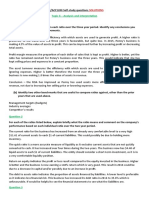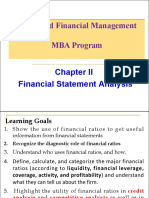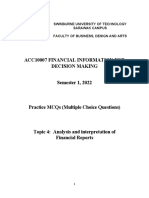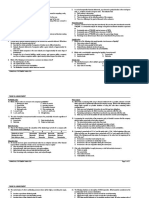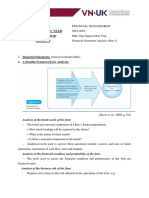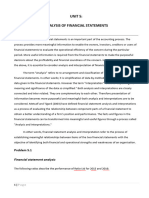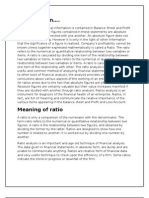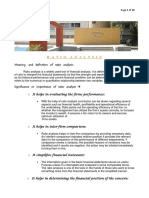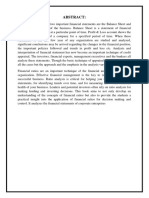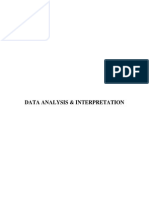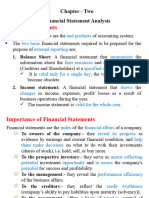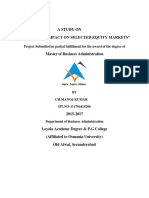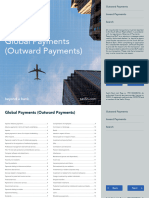Learning Management System
Subject Name Introduction to Finance and Technology
Topic Ratio Analysis
Week 5
Name : ……….…………………….……………….. Lecturer : .................................
Intake : …………………..………….…..………...…. Date : .………..…………......
1. What are some common reasons for analyzing a firm’s financial statements?
Evaluate the performance of employee and determine their pay raises and bonuses
Compare the firm’s different divisions in terms of their financial performance
Prepare financial projections such as those associated with the launch of a new
product.
2. Why are ratios helpful in financial statement analysis?
It measures the financial performance of company in terms of liquidity, efficiency,
profitability and stability in long run.
3. What are the five basic questions that we address with financial statement analysis?
How liquid is the firm?
How has the firm financed the purchase of its assets?
How efficient has the firm’s management been in utilising its asset to generate
sales?
Has the firm earned adequate returns on its investment?
Are the firm’s managers creating value for shareholders?
4. What does the term liquidity mean in the context of a firm’s financial condition, and what
financial ratios can the analyst use to access liquidity?
Has the ability to pay its bills on time or meet short term obligations
Page 1 of 5
This material is only for viewing purposes. Do not print and distribute.
� Learning Management System
Current ratio, acid test ratio, average collection period, accounts receivable turnover,
inventory turnover.
5. Apex Fabricating has $3,000,000 in cash and a total of $12,000,000 in current assets. The
firm’s current liabilities equal $6,000,000, so the firm’s current ratio equals to 2. The
company managers want to reduce the firm’s cash holdings down to $1,000,000 by
paying $500,000 in cash to expand the firm’s truck fleet and using $1,500,000 in cash to
retire a short note. If they carry this plan through, what will happen to the firm’s current
ratio?
CR = 2.22
6. Bauman Company’s total current assets, total current liabilities, and inventory for each of
the past 4 years follow:
a. Calculate the firm’s current and quick ratios for each year. Compare the resulting time
series for these measures of liquidity.
b. Comment on the firm’s liquidity over the 2012–2013 period.
The current ratio and quick ratio has decreased by 0.14 and 0.03 respectively.
7. Joyce Cheung has compiled some of her personal financial data to determine her liquidity
position. The data are as follows.
Page 2 of 5
This material is only for viewing purposes. Do not print and distribute.
� Learning Management System
a) Calculate Joyce’s liquidity ratio
2.83
b) Several of Joyce’s friends have told her that they have liquidity ratios of about 1.9. How
would you analyze Joyce’s liquidity relative to her friends?
Based on Joyce’s liquidity ratio, it indicates that she has $2.83 assets for every $1 of
liabilities. This shows Joyce didn’t utilise the assets fully compared to her friends.
8. Efficient Production Incorporation has annual sales of $5.8 million and a gross profit
margin of 30%. Its end-of-quarter inventories are:
a. Find the average quarterly inventory, and use it to calculate the firm’s inventory turnover
and the average age of inventory.
b. Assuming that the company is in an industry with an average inventory turnover of 4.8,
how would you evaluate the activity of Efficient Production’s inventory?
Based on the inventory turnover ratio of 7.42 times indicates that Efficient Production
Incorporation is having bette turnover ratio compareable to the industry ratio.
9. Pelican Paper, Inc., and Timberland Forest, Inc., are rivals in the manufacture of craft
papers. Some financial statement values for each company follow. Use them in a ratio
analysis that compares the firms’ financial leverage and profitability.
Page 3 of 5
This material is only for viewing purposes. Do not print and distribute.
� Learning Management System
a. Calculate the following debt and coverage ratios for the two companies. Discuss their
financial risk and ability to cover the costs in relation to each other.
1. Debt ratio
2. Times interest earned ratio
b. Calculate the following profitability ratios for the two companies. Discuss their
profitability relative to one another.
1. Operating profit margin
2. Net profit margin
3. Return on total assets
4. Return on common equity
c. In what way has the larger debt of Timberland Forest made it more profitable than
Pelican Paper? What are the risks that Timberland’s investors undertake when they
choose to purchase its stock instead of Pelican’s?
10. McDougal Printing, Inc., had sales totaling $40,000,000 in fiscal year 2015. Some ratios
for the company are listed below. Use this information to determine the dollar values of
various income statement and balance sheet accounts as requested.
Page 4 of 5
This material is only for viewing purposes. Do not print and distribute.
� Learning Management System
Calculate values for the following:
a. Gross profits – 32 m
b. Cost of goods sold – 8m
c. Operating profits – 14m
d. Operating expenses -18m
e. Earnings available for common stockholders – 3.2m
f. Total assets – 20m
g. Total common stock equity – 16m
h. Accounts receivable = 6,816,438.36
Page 5 of 5
This material is only for viewing purposes. Do not print and distribute.


